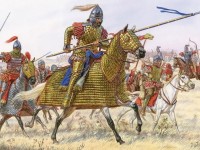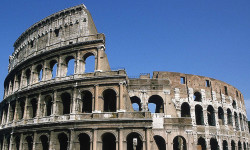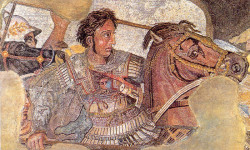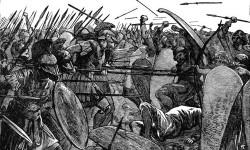While the Western Roman Empire had already decayed, the Eastern Roman Empire survived for centuries. Part of this remainder was the Byzantine Empire, which moved geographically in the direction of Asia and the inhabitants, however, always understood as a Roman and continued to retain the old legionary structures even after the collapse of the Roman Empire. Likewise the principle of Roman discipline, order and logistics.
In the 6th century, the then emperor Justinian I even pursued the goal of carrying out the renewal of the empire. That these were not just empty words, the emperor owed mainly to his commander Belisarius.
This was the supreme command in the Iberian War issued in 528, which was about the conflict between the Byzantine Empire and the Persian Sassanid Empire of the small Caucasus empire Iberia turned what smoldered for years and then ended in a war. In 530 Belisar gained a victory at Dara, and a year later after a stalemate at Callinicum, the two kingdoms agreed to a peace.
Strengthened by the campaign against the Sassanidische empire pursued emperor Justinian I. further its goal the West Roman realm again to be resurrected. His next target this time was in the conquest of the Wandal Empire in North Africa. Also for this campaign received his general Belisar the supreme command, which sailed in the year 533 with a small fleet of 10,000 infantry and about 5,000 riders in the direction of North Africa.
It was a quick victory, first fell Ad Decimum, then Carthage fell into Byzantine hands and was incorporated into the kingdom.
Spurred on by the military victories in the Middle East and Africa, Emperor Justinian I restored his successful general Belisar in the reconquest of the Italian mainland. This marched in 535 in Italy, which at that time was firmly in the Eastern Gothic hand. As early as 536, the city of Rome could be taken and secured, but the campaigns in the rest of the country proved to be much more difficult than initially thought. Although the city of Ravenna, the basis of the Ostrogoths, could still be conquered in 540 and declared the capital of the rebuilt western kingdom, this success could last only a few years.
Thus Byzantine armies became more and more defensive in 568, when the Germanic Lombards invaded Italy from the north, and the conflict with the Persian empire flared up again, and from 577 the Slavs and Avars from the north and east pushed further and further into the territory of the Balkans.
Especially the conflict with the Persian empire put the Byzantine army to the test. At the beginning of the resurgent conflict, the Persians were hard on the Byzantines with their kataphracks. This heavily armored cavalry with its lances could oppose the Byzantine infantry nothing comparable, so that Byzantines after the first shock had even set up such units and this has led to a grueling stalemate with the Persian Empire, which was later used by the Arabs, when they had an easy game against the severely weakened armies.
You can find the right literature here:
The Byzantine Empire: A Complete Overview Of The Byzantine Empire History from Start to Finish (Ancient Civilizations)

The Byzantine Empire: A Complete Overview Of The Byzantine Empire History from Start to Finish (Ancient Civilizations) Paperback – August 19, 2018
If you asked someone today when the Roman Empire ended, they might tell you 476 CE, the year that the final Roman Emperor in the west died. If you had asked someone at the time though, they might have told you that Rome was still very much alive—in Constantinople. The civilization known to us as the Byzantine Empire was known in its day as the continuation of Rome and everything it had represented. The Byzantines were not simply persistent Romans: they were their own distinct and long-lived society, both Roman and more. At its territorial zenith, it was an empire that spanned across the Mediterranean, and at its peak, it was the most powerful state in eastern Europe.
From Constantine’s founding of Constantinople in 330 CE to the city’s fall in 1453 CE, the city and all that was controlled from it had an impact on the world, well beyond its boundaries. As the second longest-lived empire in the history of the world, one might say that this was inevitable, but it was the leadership it had during the best periods in its history that truly made the difference. A truly captivating period, the history of the Byzantine Empire will give readers stories of order and chaos, glory and catastrophe, Paganism and Christianity.
The Byzantine Empire: A Captivating Guide to Byzantium and How the Eastern Roman Empire Was Ruled by Emperors such as Constantine the Great and Justinian

The Byzantine Empire: A Captivating Guide to Byzantium and How the Eastern Roman Empire Was Ruled by Emperors such as Constantine the Great and Justinian Paperback – June 4, 2018
The Byzantine Empire was founded during the chaotic third century. It was the time when revolts and civil wars were common, and Roman emperors merely lasted for a year.
Despite being one of the most captivating historical periods of all time, the Byzantine Empire is a lesser known one and it's rare to find a page-turning resource on the topic.
But that is about to change. In this new captivating history book, you will...
- explore a story of power and glory, anarchy and order, paganism and Christianity, war and peace, the West and the East
- get familiar with the roots of the greatest controversies that defined the history of Europe and the entirety of Western civilization – the conflict between the Catholic and Orthodox churches, and the one between Christianity and Islam
- discover stories of remarkable emperors you’ve never heard of and about the astonishing bravery of Graeco-Roman heroes such as Constantine Dragases, who resisted the Ottomans until the end, and Belisarius, who fought the Persians to reconquer what used to be the Western Empire
- learn more about the entire era called the Byzantine Empire in less time compared to reading boring textbooks
Lost to the West: The Forgotten Byzantine Empire That Rescued Western Civilization
Filled with unforgettable stories of emperors, generals, and religious patriarchs, as well as fascinating glimpses into the life of the ordinary citizen, Lost to the West reveals how much we owe to the Byzantine Empire that was the equal of any in its achievements, appetites, and enduring legacy.
For more than a millennium, Byzantium reigned as the glittering seat of Christian civilization. When Europe fell into the Dark Ages, Byzantium held fast against Muslim expansion, keeping Christianity alive. Streams of wealth flowed into Constantinople, making possible unprecedented wonders of art and architecture. And the emperors who ruled Byzantium enacted a saga of political intrigue and conquest as astonishing as anything in recorded history.
Lost to the West is replete with stories of assassination, mass mutilation and execution, sexual scheming, ruthless grasping for power, and clashing armies that soaked battlefields with the blood of slain warriors numbering in the tens of thousands.
The Cambridge History of the Byzantine Empire c.500-1492
Byzantium lasted a thousand years, ruled to the end by self-styled 'emperors of the Romans'. It underwent kaleidoscopic territorial and structural changes, yet recovered repeatedly from disaster: even after the near-impregnable Constantinople fell in 1204, variant forms of the empire reconstituted themselves. The Cambridge History of the Byzantine Empire c.500-1492 tells the story, tracing political and military events, religious controversies and economic change. It offers clear, authoritative chapters on the main events and periods, with more detailed chapters on outlying regions and neighbouring societies and powers of Byzantium. With aids such as maps, a glossary, an alternative place-name table and references to English translations of sources, it will be valuable as an introduction. However, it also offers stimulating new approaches and important findings, making it essential reading for postgraduates and for specialists. The revised paperback edition contains a new preface by the editor and will offer an invaluable companion to survey courses in Byzantine history.
This post is also available in:
 Deutsch (German)
Deutsch (German)  Français (French)
Français (French)  Italiano (Italian)
Italiano (Italian)  简体中文 (Chinese (Simplified))
简体中文 (Chinese (Simplified))  Русский (Russian)
Русский (Russian)  Español (Spanish)
Español (Spanish)  العربية (Arabic)
العربية (Arabic)


















